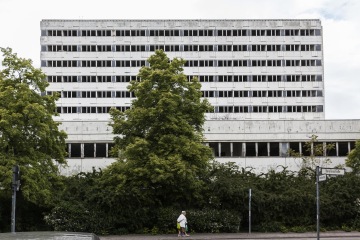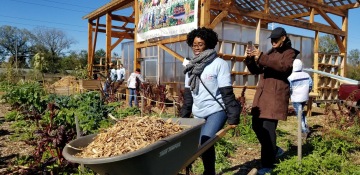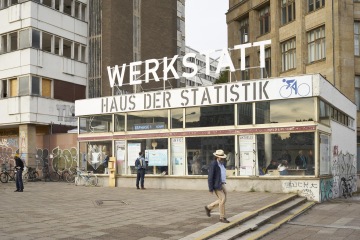
Leona Lynen on Planning Incomplete Cities
Leona Lynen sets a path for a publicly-planned revitalization of Berlin’s Haus der Statistik in the wake of a unique opportunity for Berliners to partner with their government.
Berlin’s Haus der Statistik—adjacent to the city’s iconic Alexanderplatz—is a site for an urbanistic vision driven by the everyday experience rather than the top-down planner. The abandoned building is massive and once housed the DDR’s statistics bureau, surviving the gentrification, population growth and exponential rent increase the city has seen over the past 15 years.
Watch: Leona Lynen on the Collaborative Regeneration of Haus der Statistik
Plans for the Haus der Statistik included extensive urban planning projects that would see the buildings destroyed to free prime real estate plots, but failed to come to fruition in the wake of the 2008 Financial Crisis. Leona Lynen, a member of the ZUsammenKUNFT collective that is overseeing a joint civil society-state partnership to prevent the site from falling victim to gentrification.
I think if we want to regenerate our cities we need to enter new collaborations that might be a bit uncomfortable at first.
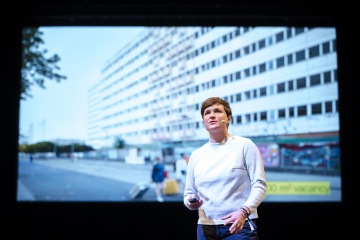
Following an artistic intervention, which Lynen described as a group of artists who “rented a spider lift, put on high visibility vests and hard helmets to look very official, and hung up a poster on the facade of Haus der Statistik,” education, and community interest grew. With the government itself moving offices due to significant rent increases, there was also interest in the Haus der Statistik serving state needs. With this, the city of Berlin decided to purchase the building from the federal government in conjunction with state-owned corporations and civil society groups to oversee its renovation.
We need to end the phase of centralized urban regeneration by the so-called experts and include people that have a say in the everyday environment.
Although Berliners, at least in Lynen’s experience, tend to have an adversarial relationship with the state, the project has become a unique opportunity for a site to fit both the needs of the city government along with the cultural and educational requests of its residents. Significant public input, as opposed to typical, top-down natures of most state-run urban planning, will be the path to co-creation of Haus der Statistik’s future.

Lynen emphasizes that in order for the building to adequately serve the public—which now includes a few hundred units of public housing—it will have to offer points of encounter that have “no flagship stores, no Starbucks”. Instead, ground-level occupation will be public-facing and mixed-use to encourage the site to become a meeting point for its community. As Berlin has done much on a larger urban scale to limit itself from becoming dominated by financial towers that are ubiquitous with downtowns of major capitals, Lynen’s project emphasizes the prioritization of residential interests on a smaller scale.
Curating ground floors oriented towards the common good, where normal, everyday people can meet and interact.
However, a smaller scale does not mean an insignificant impact. Given its central location, the complex has the potential to become a major public site. Although it will host a relocated town hall and offices for a few state-owned organizations, its extension of invitations to occupy existing ground-floor units prior to being fully renovated has featured “pioneers” that will test and transform the space with various interim arts, education and culture programs to prototype how sharing of space and resources will work.
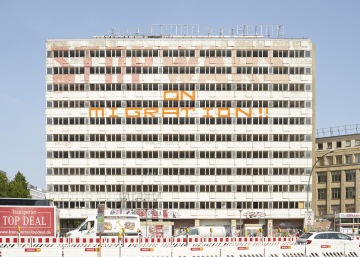
Lynen ultimately sees the project as a way for the public to have more of a say in their city’s urban planning projects. Public participation in the project has ranged from “a cup of tea with the granny next door,” to people coming in “to ask what’s going on in their immediate environment” A stark contrast with prior plans for an overhaul of blocks around Alexanderplatz.
I think we truly do complement and amplify each other’s strengths and each other’s tactics. I think if we enter into these collaborations we can make a way for open, alive, diverse, and incomplete cities.
The collective established an office for the public to access information and act as receptacle for input and public participation surrounding the renovation. Lynen shares the foundation of the collaboration as an entrance into "amplifying each other's strengths and tactics" to make way for "open, alive, diverse and incomplete cities" that seeks to incorporate the building into serving the everyday needs of Berliners.
Leona Lynen spoke at reSITE REGENERATE and is featured on reSITE's podcast, Design and the City.
More ideas on building incomplete cities and other bottom up intiatives
Fighting Gentrification, Berlin-Style with Leona Lynen
A vast, unoccupied administration building in the heart of Berlin at Alexanderplatz - Haus der Statistik - has become a prototype for gentrification done right. Hear from Leona, a member of the cooperative, ZUsammenKUNFT, as she discusses how they are developing a mixed-use urban space oriented towards the common good. Photo courtesy of Nils Koenning
Emmanuel Pratt on Regenerating Urban Ecology
Emmanuel Pratt, MacArthur fellow and founder of Sweet Water Foundation, regenerates neighborhoods by fusing architecture & community development.
Jee Liu on Applying Subtle Design to Adaptive Reuse
At the core of WallaceLiu’s projects is a design practice called adaptive reuse. In the age of the quest for sustainability, adaptive reuse is becoming more of a necessity for city-makers worldwide.
Ravi Naidoo on Design in Service of People
Founder of Interactive Africa and Design Indaba, Ravi Naidoo challenges his audience at reSITE to reframe what they believe the purpose of design is for.
